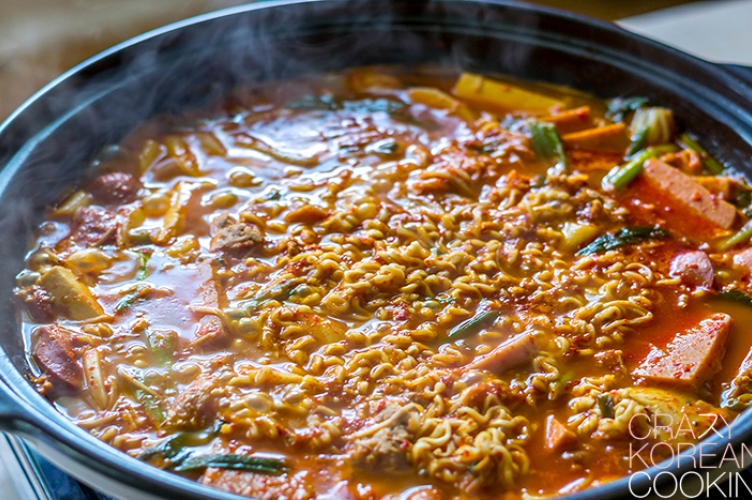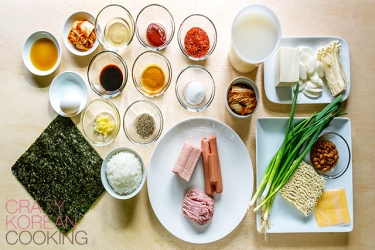Budae Jjigae, Army Stew
부대찌개

Budae Jjigae, or army stew, originated shortly after the Korean War when food was scarce and many Koreans were starving. Food was smuggled from American military bases, and then local Koreans used the American ingredients to create a stew. With processed meats such as spam and hot dogs, the stew became an assortment of Korean vegetables, spicy seasonings and other leftovers thrown together into a large pot. This is how Budae Jjigae came to be; created out of necessity during a difficult time.
Army stew is still popular in South Korea. It's a trendy table-cooking food in restaurants and often eaten while drinking soju (rice liquor). Budae Jjiage has evolved since its post-war origins. It now has more Korean ingredients such as ddeok (rice cakes), kimchi, gochujang and various types of noodles.
How does this crazy combination of East-meets-West flavors taste? Surprisingly good! Budae Jjiage's flavor is complex, yet well balanced and definitely has a spicy kick. Serve this dish at your next dinner party. It will be unforgettable!
Buy Korean ingredients online here.
Budae Jjigae, or army stew, originated shortly after the Korean War when food was scarce and many Koreans were starving. Food was smuggled from American military bases, and then local Koreans used the American ingredients to create a stew. With processed meats such as spam and hot dogs, the stew became an assortment of Korean vegetables, spicy seasonings and other leftovers thrown together into a large pot. This is how Budae Jjigae came to be; created out of necessity during a difficult time.
Army stew is still popular in South Korea. It's a trendy table-cooking food in restaurants and often eaten while drinking soju (rice liquor). Budae Jjiage has evolved since its post-war origins. It now has more Korean ingredients such as ddeok (rice cakes), kimchi, gochujang and various types of noodles.
How does this crazy combination of East-meets-West flavors taste? Surprisingly good! Budae Jjiage's flavor is complex, yet well balanced and definitely has a spicy kick. Serve this dish at your next dinner party. It will be unforgettable!
Buy Korean ingredients online here.
INGREDIENTS
shop these ingredients online »main ingredients | ||
| 6 cups | Beef Bone Broth 사골육수 (or anchovy broth or broth of your choice, may need less if NOT table-cooking | |
| 5 oz | Spam 스팸 | |
| 4 oz | Hotdog 소세지 | |
| 4 oz | Ground Pork 간 돼지고기 (can also use beef or other meat) | |
| 6 oz | Tofu, Soft or regular (for stew) 두부 (찌개용) (optional) | |
| 2 oz | Baked Beans 빈즈 (in a can, optional) | |
| 4 oz | Kimchi 김치 (over fermented sour kimchi is better) | |
| 6 | Green Onion 파 | |
| 2 oz | Enochi Mushroom 팽이버섯 (or your favorite mushroom) | |
| 1 | Instant Noodle 라면 (or 2 oz of cooked macaroni) | |
| 3 oz | Rice Cake for soup, Sliced Garae Ddeok 떡국떡 (optional) | |
| 1 sheet | Processed Cheese (optional) | |
for broth seasoning | ||
| 1 tbs | Gochujang (Hot Pepper Paste) 고추장 | |
| 3 tbs | Gochugaru, Korean Hot Pepper Flakes 고춧가루 | |
| 1 tbs | Sugar 설탕 (optional, or 2 tbs of maesil-jeup, Asian plum extract) | |
| 1 tbs | Anchovy Fish Sauce 멸치액젓 (optional or 1 additional tsp of soy sauce) | |
| 3 tbs | Cheongju, Korean Rice Wine 청주 (or white wine) | |
| 1 tsp | Soy Sauce (regular) 왜간장 | |
| 1 tbs | Garlic (minced) 다진 마늘 | |
| ⅔ tsp | Black Pepper 후추 | |
for making fried rice (optional second course for table cooking) | ||
| 1 cup ⅔ tbs | Cooked Rice 밥 | |
| 2 oz | Kimchi 김치 (finely chopped) | |
| 1 tbs | Sesame Oil 참기름 | |
| 2 sheet | Seaweed (Gim, Laver) 김 (8" by 8" sheet or equivalent, can use less or more to your preference) | |
| 1 | Egg 계란 (cracked) | |

Good to Know
Many of the ingredients such as spam, hot dogs and beans are already seasoned. So depending on the amount of these ingredients you use, the stew may become more or less salty. If you are not sure, you can always hold back some of the seasoning sauce in the beginning and gradually add it as you taste the stew.
You can add more rice cake and/or noodles if you like. But, if you add too much of them, the stew will become too thick and starchy.
More questions? Please leave your questions in the comments section below. We will do our best to answer as soon as we can.
instructions |
photos |
summary |
|---|---|---|
Ingredient amounts in the recipe instructions are for the default serving size. |
Click to enlarge photos. |
Ingredient amounts in the recipe summary are for the default serving size. |
1. Make seasoning sauceIn a bowl, put 1 tbs of gochujang (hot pepper paste), 3 tbs of gochugaru (hot pepper flakes), 1 tbs of sugar, 1 tbs of anchovy fish sauce, 3 tbs of rice wine, 1 tsp of soy sauce, 1 tbs of minced garlic and ½ tsp of black pepper. Mix well and set it aside. Let it mature for about 30 min. (If you have time, mature the sauce overnight.) |
1
Mix
| |
2. Soak rice cake (optional)Soak rice cake in cold water for about 30 minutes (optional). *This is optional, but pre-soaking will reduce the cooking time and make the broth less starchy. If you like starchy broth, don’t pre-soak and add rice cake at the beginning. |
2
Soak
| |
3. Cut spamCut 5.3 oz (150g) of spam into thin two bite-size pieces (approximately 1.5” x 1.5” x ¼” or 4 cm x 4 cm X 0.6 cm). |
3
Cut into two bite size
| |
4. Cut TofuCut 6 oz (170g) of tofu into two bite-size pieces. Don’t cut it too thinly. It may break. (approximately 1.5” x 1.5” x 3/8” or 4 cm x 4 cm X 0.9 cm). |
4
Cut into two bite size
| |
5. Slice hot dogsSlice 4 oz (113g) of hot dogs (or sausages) diagonally. |
5
Slice diagonally
| |
6. Chop kimchiChop 4 oz (113g) kimchi into bite size pieces. |
6
Chop into bite size
| |
7. Wash enochi mushroomWash 2 oz (56g) enochi mushroom. |
7
Enochi mushroom
| |
8. Cut green onionsWash, peel and cut 5 green onions diagonally. |
8
Green onion
| |
9. Arrange the ingredientsIn a shallow wide pot, arrange spam, hot dogs, ground pork, tofu, baked beans, kimchi and enochi mushroom. Add the seasoning sauce from step 1 in the middle and green onions on top. Pour 4 cups of beef bone broth (or your choice of broth) over the ingredients. *Leave 2 cups of broth for later. |
9
Arrange
Add
| |
10. Table cookingTypically, Koreans will cook this on a portable stove while everyone is seated at the dinner table. But, you can certainly cook it on a regular stove and serve it. Bring the stew to boil on high heat. |
10
Bring to boil
| |
11. Add instant noodlesOnce the stew comes to a boil, let it boil for about 5 minutes on high heat. Then add instant noodles (broken in half) and rice cake. *Do not add the seasoning that comes with the instant noodles. Add a slice of cheese on top (optional). Stir and turn over all the ingredients with tongs or a ladle. |
11
Let it boil High Heat Add
| |
12. ServeWhen the instant noodles are cooked (soft), the stew is ready to be served. Serve with a bowl of rice on the side. If you are table-cooking, turn down the heat to low and let it simmer as you eat. Add more broth if the stew gets boiled down and becomes too thick or salty. Koreans often eat out of a communal pot when eating stews. But you can have individual bowls on the table if you like. |
12
Serve
If table-cooking
| |
13. Fried Rice I (Optional second course)After finishing the soup, remove the liquid from the pot leaving a very small amount of broth at the bottom. Add the rice mix (cooked rice, chopped kimchi, crumbled seaweed sheets, cracked egg and sesame oil) into the pot and stir-fry on high heat for 3 min. |
13
Leave a little bit of soup Add rice mix Stir-fry High Heat | |
14. Fried Rice II (Optional second course)Pat down the rice so it’s leveled and turn down the heat to low. Leave it for 5-10 min for the rice to form a crispy crust at the bottom. Turn off the heat and enjoy your fried rice! |
14
Level the rice and turn down heat Low Heat Enjoy! |












 30 min
30 min
